UMass Extension's Landscape Message is an educational newsletter intended to inform and guide Massachusetts land care professionals in the management of our collective landscape. Detailed reports from scouts and Extension specialists on growing conditions, pest activity, and cultural practices for the management of woody ornamentals, trees, and turf are regular features. The following issue has been updated to provide timely management information and the latest regional news and environmental data.
Welcome to Landscape Message #10 for the 2024 growing season. The next message will be published in one week, on June 21. To receive immediate notification when the next Landscape Message update is posted, be sure to join our e-mail list
Click on the headings below to jump to that section of the message.
In This Issue
Scouting Information by Region
Woody Ornamentals
Scouting Information by Region
Environmental Data
The following data was collected on or about June 12, 2024. Total accumulated growing degree days (GDD) represent the heating units above a 50ºF baseline temperature collected via regional NEWA stations (http://newa.cornell.edu) for the 2024 calendar year. This information is intended for use as a guide for monitoring the developmental stages of pests in your location and planning management strategies accordingly.
|
MA Region/Location |
2024 Growing Degree Days |
Soil Temp |
Precipitation |
Time/Date of Readings |
||
| Gain since last report |
2024 total |
Sun |
Shade |
|||
|
CAPE |
105 |
427 |
69 |
65 |
0.22 |
12:00 PM 6/12/2024 |
|
SOUTHEAST |
116 |
556 |
75 |
65 |
0.50 |
3:00 PM 6/12/2024 |
|
NORTH SHORE |
99 |
447 |
64 |
58 |
0.15 |
10:00 AM 6/12/2024 |
|
EAST |
114 |
573 |
70 |
65 |
0.22 |
4:00 PM 6/12/2024 |
|
METRO |
112 |
564 |
62 |
58 |
0.28 |
6:00 AM 6/12/2024 |
|
CENTRAL |
107 |
571 |
64 |
60 |
0.29 |
7:00 AM 6/12/2024 |
|
PIONEER VALLEY |
97 |
601 |
68 |
63 |
0.85 |
1:00 PM 6/12/2024 |
|
BERKSHIRES |
82 |
515 |
63 |
58 |
1.31 |
7:00 AM 6/12/2024 |
|
AVERAGE |
104 |
532 |
67 |
62 |
0.48 |
- |
|
n/a = information not available |
||||||
US Drought Monitor: At this time, parts of Hampshire, Franklin, and Berkshire County, making up about 10% of the state's area, are classified as "D0 - Abnormally Dry". State map as of Thursday 6/13
Phenology
| Indicator Plants - Stages of Flowering (BEGIN, BEGIN/FULL, FULL, FULL/END, END) | ||||||||
|---|---|---|---|---|---|---|---|---|
| PLANT NAME (Botanic / Common) | CAPE | S.E. | N.S. | EAST | METRO W. | CENT. | P.V. | BERK. |
|
Itea virginica (Virginia sweetspire) |
* |
* |
Begin |
Begin |
Begin |
Begin |
Begin/Full |
Begin |
|
Ligustrum spp. (privet) |
Begin |
* |
* |
* |
Begin |
* |
Begin |
* |
|
Catalpa speciosa (Northern catalpa) |
Begin |
Begin |
Full |
Begin/Full |
Full |
Begin |
Full |
Begin/Full |
|
Sambucus canadensis (American elderberry) |
* |
Begin |
Full |
Full |
Full |
Begin/Full |
Full |
Begin |
|
Kalmia latifolia (mountain laurel) |
Full |
Full |
Full |
Full/End |
Full/End |
Full |
Full/End |
Full |
|
Cotinus coggygria (common smokebush) |
Begin/Full |
Full |
Full/End |
Full/End |
Full/End |
Full |
Full/End |
Full/End |
|
Weigela florida (old fashioned weigela) |
Full/End |
Full |
Full/End |
Full/End |
Full/End |
Full/End |
End |
Full |
| * = no activity to report/information not available | ||||||||
Regional Notes
Cape Cod Region (Barnstable)
General Conditions:
The average temperature for the period from June 5 to June 12 was 64ºF, with a high of 76ºF on June 5 and 7 and a low of 56ºF on June 12. High temperatures have been in the 70s and lows have been in the 50s. Just under a quarter inch of precipitation fell during the period. Soil moisture is short.
Herbaceous plants seen in bloom include peony (Paeonia ssp.), foxglove (Digitalis pupurea), false indigo (Baptisia australis), goatsbeard (Arunus dioicus), and speedwell (Veronica spp.). Woody plants seen in bloom include arrowwood (Viburnum dentatum), tree lilac (Syringa reticulata), Japanese spirea (Spiraea japonica), tuliptree (Liriodendron tulipifera), sheep laurel (Kalmia angustifolia), and American holly (Ilex opaca).
Pests/Problems:



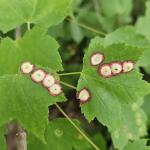

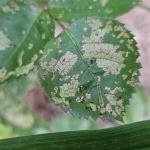
 Keep an eye out for box tree moth, this insect should be scouted for regularly. Several unmanaged plantings have quickly been killed this spring as a result of feeding and defoliation.
Keep an eye out for box tree moth, this insect should be scouted for regularly. Several unmanaged plantings have quickly been killed this spring as a result of feeding and defoliation.
Some spotty defoliation has been observed in the mid-Cape area, primarily as a result of fall cankerworm. Numerous pests of oak have been observed including oak shot hole leafminer, sawfly, lecanium scale, spongy moth, and winter moth damage. Scout for spongy moth and lecanium scale.
Other insects or insect damage observed during the period includes eastern tent caterpillar on black cherry, viburnum leaf beetle on arrowwood, dogwood sawfly on alternate leaf dogwood, maple eyespot gall midge damage on red maple, daylily leafminer damage on daylily, columbine leafminer damage on columbine, earwig damage on butterfly bush, plant bug damage on viburnum, woolly aphid on beech, black turpentine beetle on pitch pine, rose slug sawfly larvae on rose, hibiscus sawfly larvae damage on hibiscus, and aphids on many woody and herbaceous plants.
Disease symptoms or signs observed during the period include white pine needle decline on white pine, ploioderma needlecast on pitch pine, brown rot on Japanese cherry, exobasidium gall on rhododendron, sycamore anthracnose, maple anthracnose, pear trellis rust on Bradford pear, cedar apple rust on crabapple, powdery mildew on smokebush, and tip blight on juniper. Beech leaf disease is everywhere and severely impacting American and European beech tree health. Red thread is active in turf.
Invasive plants seen in bloom during the period include scotch broom (Cytisus scoparius), multiflora rose (Rosa multiflora), buckthorn (Rhamnus cathartica), and black swallowwort. Other weeds seen in bloom include white clover (Trifolium repens), black medic (Medicago lupulina), and hawkweed (Hieracium pratense).
Snail and slug damage was seen on numerous herbaceous perennials including hosta, false indigo, and lupine.
Southeast Region (Dighton)
General Conditions:
Over the past week since Wednesday, June 5th, the highest temperature was 82ºF on the 5th, while the lowest temperature was 54ºF overnight on Tuesday, June 11th. The average temperature for the week was around 70ºF. There was rain on the morning of Thursday, June 6th, with an accumulation of 0.50 inches. The highest wind speed was 14 mph from the south-southeast on June 5th and from the west on Saturday, June 8th. Soil temperatures reached 75ºF in full sun and 65ºF in shade as of 3:00 PM on Wednesday, June 12th.
Plants currently in flower include Catalpa speciosa (Northern catalpa), Chionanthus virginicus (fringe tree), Cornus kousa (Kousa dogwood), Cornus sericea (red osier dogwood), Cotinus coggygria (common smokebush), Hydrangea anomala petiolaris (climbing hydrangea), Kalmia latifolia (mountain laurel), Kolkwitzia amabilis (beautybush), Sambucus canadensis (American elderberry), Syringa Meyer (Meyer lilac), S. reticulata (Japanese tree lilac), and Weigela florida (old fashioned weigela)
Pests/Problems
Beech leaf disease has been reported in Rehoboth.
Heavy clouds of white pine pollen continue to be an issue, coating everything in yellow and inducing coughing and itching eyes. Coincident with shedding pollen, many pines are turning brown from needle disease.
North Shore (Beverly)
General Conditions:
The weather during this reporting period was very comfortable for outdoor activities. The days were mostly sunny or partially sunny. Day temperatures were in the high 60s to low 70s and the night temperatures were mostly in the mid 50s. The average daily temperature was 64ºF with the maximum temperature of 74ºF recorded on June 10 and the minimum temperature of 54ºF recorded on June 12. Very little precipitation was received during this period. Approximately 0.15 inch of rain was recorded at Long Hill during this reporting week, which came on Sunday June 9. We need more rain in the coming weeks or else plants will start to show signs of water stress.
Woody plants in bloom include: Chinese dogwood (Cornus kousa), arrowwood viburnum (Viburnum dentatum), mock orange (Philadelphus spp.), beautybush (Kolkwitzia amabilis), mountain laurel (Kalmia latifolia), weigela (Weigela florida), Korean dogwood (Cornus coreana), stewartia (Stewartia rostrata), stiff dogwood (Cornus foemina), American holly (Ilex opaca), Japanese snowbell (Styrax japonica), and black elderberry (Sambucus nigra). Non-woody plants seen in bloom include: bush cinquefoil (Potentilla fruticosa), foam flower (Tiarella cordifolia), fetterbush (Leucothoe fontanesiana), peony (Paeonia sp.), cranesbill (Geranium sp.), bleeding heart (Lamprocapnos spectabilis), redleaf rose (Rosa glauca), Rodger's flower (Rodgersia aesculifolia), goatsbeard (Aruncus dioicus), Japanese primrose (Primula japonica), water lily (Nymphaea odorata), columbine (Aquilegia spp.), sweet woodruff (Galium odoratum), and annuals such as petunia and million bells.
Pests/Problems:
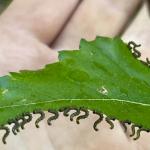
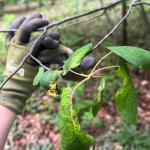 Imported willow leaf beetle larvae were observed damaging leaves of pussy willow. The larvae are small, greenish-black grubs. They skeletonize the undersides of leaves, and as they grow older, they begin feeding on the tops of leaves, sometimes chewing holes through them.
Imported willow leaf beetle larvae were observed damaging leaves of pussy willow. The larvae are small, greenish-black grubs. They skeletonize the undersides of leaves, and as they grow older, they begin feeding on the tops of leaves, sometimes chewing holes through them.
Multiflora rose (Rosa multiflora), wine raspberry (Rubus phoenicolasius), garlic mustard (Alliaria petiolata), and several other weeds are in full bloom.
Leaf and flower galls (Exobasidium vaccinii) on some azaleas and rhododendrons are turning white with spores. Prune out the galls and discard them before they start to release spores.
Mosquitoes and ticks are still very active. Protect yourself with insect repellent when working outdoors, especially at dawn and at dusk.
East (Boston)
General Conditions:
The sun rose at 5:06 0n June 11th, the earliest of the year. We had a dry week; despite the threat of a passing front, we received only 0.22 inches of precipitation. Daytime high temperatures averaged 76ºF with a high of 86ºF on the 5th. Overnight temperatures averaged 58ºF. We have reached 553 Growing Degree Days (base 50).
Some plants in bloom include; Aruncus dioicus (goatsbeard), Calycanthus floridus (Carolina allspice), Campanula takesimana (Korean bellflower), Digitalis purpurea (common foxglove), Itea virginica ‘Little Henry’ (Virginia sweetspire), Oenothera fruticosa (narrow-leaf evening primrose), and Penstemon digitalis (foxglove beardtounge).
Pests/Problems:
Having received only 0.22 inches of precipitation this week, recent transplants and containers require supplemental irrigation. Woolly beech aphids (Phyllaphis fagi) are congregating on the foliage of Fagus sylvatica (European beech). Viburnum dentatum (arrowwood) along woodland edges have been completely defoliated by viburnum leaf beetle larvae (Pyrrhalta viburni). The invasive mile-a-minute vine (Persicaria perfoliatum) is making its way from woodland edges into the meadows. Cynanchum louiseae (black swallowwort) is flowering. Fallopia japonica (formerly Polygonum cuspidatum) (Japanese knotweed) is flourishing along unmanaged roadsides.
Metro West (Acton)
General Conditions:
The gorgeous late spring-early summer-like weather continued into this week’s reporting period. High temperatures were recorded in the 80’s, with a high temperature of 86º recorded on the 5th, and cool nights prevailed. Rain has been hit or miss. For June, the average monthly rainfall is 3.93” and so far, I have recorded 0.28” of rain for this area.
Observed in some stage of bloom this past week were the following plants: Aruncus dioicus (goat’s beard), Asclepias syriaca (common milkweed), Buddleia spp. (butterfly-bush), Campanula takesimana ‘Elizabeth’ (bell flower), Dictamnus albus (gas plant), Digitalis purpurea (foxglove), Hydrangea anomala petiolaris (climbing hydrangea), Itea virginica (Virginia sweetspire), Lychnis coronaria (rose campion), Penstemon digitalis 'Husker Red' (beardtongue), Rhododendron viscosum (swamp azalea), Rosa gallica (French rose), Rubus odoratus (purple flowering raspberry), Spiraea japonica 'Alpina' (daphne spirea), and Thermopsis caroliniana (southern lupine).
Pests/Problems:
Many of our most invasive weeds have flowered and are beginning to set seed. Those include: Alliaria petiolata (garlic mustard), Berberis thunbergii (barberry), Elaeagnus umbellata (Autumn-olive), Euonymous alatus (burning bush), and Rhamnus cathartica (common buckthorn). Rosa multiflora (multiflora rose), a woody vine with many, noticeable, simple white flowers continues to bloom.
Central Region (Boylston)
General Conditions:
It was a hot start to the beginning of the report cycle, then temperatures cooled as the week went on. We received little to no rain as things continued to dry out. Max precipitation was 0.23 on the 9th. Temperatures stayed mostly in the 70s with days in the 80s; the highest recorded was 86.4ºF on the 7th. It has been dry and breezy. The rain received unfortunately didn’t seem to saturate the soil much.
Some woody plants that can be seen blooming currently are mountain laurel (Kalmia latifolia), maple-leaf viburnum (Viburnum acerfolium), Carolina rose (Rosa carolina), flame azalea (Rhododendron calendulaceum), and swamp azalea (Rhododendron viscosum). Some herbaceous material that also can be seen blooming are peony (Peaonia spp.), beardtongue (Penstemon digitalis), yarrow (Achillea millefolium), and common milkweed (Asclepias syriaca).
Pests/Problems:
It seems that such a wet spring has harbored favorable conditions for different fungal problems, such as that affecting Amelanchier spp., for example. The presence of fungal leaf spot is seen in different landscape areas, which also seems to be paired with insects eating the foliage as a secondary problem. Another pest spotted during this time is the dusky birch sawfly (Croesus latitarsus) on Betula spp., primarily gray birch (Betlua populifolia). Leaves are starting to defoliate from the margins inward, which will eventually lead to complete defoliation in smaller trees. One problem plant that can be seen in full bloom and continuing its spread is multiflora rose (Rosa multiflora).
Pioneer Valley (Amherst)
General Conditions:
Mild, seasonable daytime high temperatures with cool nights occurred over this recent reporting period in the Pioneer Valley. After stretches of hot and sometimes humid conditions in late May and early June, this cooling trend was welcome. Soil moisture remains decent with scattered showers on 6/6 and 6/9. Drier, full sun sites need more rainfall. However, water usage and transpirational loss was reduced with the cooler conditions this past week. Soil temperatures also decreased in full sun.
White clover (Trifolium repens) is really having a year and seems to be flowering everywhere in the valley. It also appears to be a strong year for woody plant growth given the abundance of rain combined with the mild winter. Insect activity is very high right now across the landscape. Pollen levels are tapering off from their peak last week as white pine production wanes. The long-term forecast is calling for some major heat, while many plants still have tender new growth.
Pests/Problems:
Symptoms of foliar anthracnose infections are appearing on a range of plants, including maple and dogwood.
On Japanese maple, pale brown spots and coalescing blotches from anthracnose are locally abundant. Bright orange-yellow cedar-apple rust leaf spots are forming on apple and crabapple. White pine needle blight is abundant, yet scattered, around the tri-counties. Some trees appear healthy with relatively little needle loss. However, many trees, especially in Franklin County, are badly diseased.
Elm sack galls are abundant on a variety of ornamental elms on the UMass campus.
Weeds are growing strong in garden beds and crabgrass has appeared.
Oriental bittersweet vines are growing rapidly right now but are easier to remove when succulent, before the vines become woody.
Berkshire Region (West Stockbridge)
General Conditions:
After a stretch of very warm weather where temperatures reached into the 80ºF range as recently as June 5, the weather took a turn to much lower temperatures throughout the county. High temperatures on June 5th were 86ºF in North Adams, 83ºF in Richmond and 80ºF in Pittsfield. Since then, the daily high temperature dropped to 63ºF in Pittsfield and 64ºF in Richmond on June 11, and 67ºF in North Adams on June 10. The overnight low temperatures for this scouting period all occurred on the morning of June 9th: 51ºF in Richmond, 52ºF in Pittsfield, and 55ºF in North Adams.
Looking ahead, it is now predicted that temperatures over the next week could soar to 90ºF or nearly so. Fortunately, the soil is currently moist and plant growth is rapid. Application of mulch around plantings will help soils retain much of the moisture as air temperatures increase. This is especially important for recently planted or transplanted plants. Keep in mind that mulches should not be piled against the stems or trunks of woody plants. Turfgrass is growing so fast that mowing every 5 days as opposed to weekly may be necessary.
Pests/Problems:
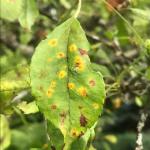

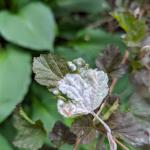 Pest activity has picked up a little but is not overwhelming except for ticks, mosquitoes, and flies of various species. The application of repellents such as those containing DEET will help deter some of these pests.
Pest activity has picked up a little but is not overwhelming except for ticks, mosquitoes, and flies of various species. The application of repellents such as those containing DEET will help deter some of these pests.
Moist conditions have favored slug and snail activity which include dining on recently planted annuals as well as established and low growing plants such as hosta. Rabbits have also joined in on the feast.
The larvae of the iris bud fly (Neorthacheta dissimilis) were reported to be infesting the flower buds of iris.
Other pests observed included: larvae of imported willow leaf beetle, aphids on many herbaceous and woody plants, and elm leafminer (Fenusa ulmi). Diseases seen were black spot on roses, cedar-apple rust, and powdery mildew on ninebark (Physocarpus opulifolius).
Regional Scouting Credits
- CAPE COD REGION - Russell Norton, Horticulture and Agriculture Educator with Cape Cod Cooperative Extension, reporting from Barnstable.
- SOUTHEAST REGION - Brian McMahon, Arborist, reporting from the Dighton area.
- NORTH SHORE REGION - Geoffrey Njue, Green Industry Specialist, UMass Extension, reporting from the Long Hill Reservation, Beverly.
- EAST REGION - Kit Ganshaw & Sue Pfeiffer, Horticulturists reporting from the Boston area.
- METRO WEST REGION – Julie Coop, Forester, Massachusetts Department of Conservation & Recreation, reporting from Acton.
- CENTRAL REGION - Mark Richardson, Director of Horticulture, and Anna Petrie, reporting from New England Botanic Garden at Tower Hill, Boylston.
- PIONEER VALLEY REGION - Nick Brazee, Plant Pathologist, UMass Extension Plant Diagnostic Lab, reporting from Amherst.
- BERKSHIRE REGION - Ron Kujawski, Horticultural Consultant, reporting from Great Barrington.
Woody Ornamentals
Diseases
Recent pests, pathogens, or problems of interest seen in the UMass Extension Plant Diagnostic Lab, a select few:
Beech leaf disease, caused by the foliar nematode Litylenchus crenatae ssp. mccannii, on American beech (Fagus grandifolia) and European beech (F. sylvatica). Samples are from trees ranging in age from ~10 years old to well over 100 years old. Symptoms include banded, thickened and distorted leaves, lower canopy dieback and severe canopy thinning. Leaf thickening and distortion appears to be worse on American beech while the banding can range in color from dark green to reddish-purple on European beech. Observed and reported results of phosphite treatments, applied as a lower trunk drench with a carrier or as a soil drench around the root flare, are mixed but many trees under this regimen are not experiencing meaningful BLD control. However, in certain cases, trees that are receiving phosphite applications and treatment with fluopyram (Broadform) have improved. For some of these trees, leaf banding and distortion has decreased from last year while for others, the symptoms have worsened but the canopies remain relatively full with no major dieback. For each individual tree, we must consider what represents meaningful BLD control. While the goal may be a complete eradication of the nematode and trees that are free of BLD symptoms, this may not be possible given the rapid and effective dispersal of the nematode, logistical challenges associated with some treatments, and current health status of an infested tree. Some beech exist in poor, compacted soils, have girdling roots from deep planting, and are suffering with branch and trunk cankers, among other health issues. Trees weakened by non-BLD stresses in areas with high nematode populations may not respond well to treatment. Even for otherwise healthy beech, keeping nematode populations at low to moderate levels may be the best-case scenario. For many trees receiving no treatment, disease incidence and severity has increased dramatically from year to year.
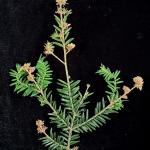
 Sirococcus shoot blight (Sirococcus tsugae) of eastern hemlock (Tsuga canadensis). The tree is roughly 12’ tall with a dbh of 4”. It seeded naturally on a woodland border and receives morning sun in good loam soils. It’s occasionally hand-watered during extended dry periods. Overtopping black birch (Betula lenta) were removed to provide more sunlight and space. Scattered dieback of the current season’s shoot tips was recently observed, and symptoms have not been present in previous years. The damage was mostly confined to shaded portions of the lower canopy. Several other hemlocks were scouted on the property with only one other (a mature tree) showing symptoms. Several trees in deep shade are free of symptoms. Sirococcus tsugae was first reported on eastern hemlock from Maine in 2009. At the time, there was significant concern about the added stress of this disease on trees infested with HWA and EHS. A subsequent survey of the pathogen in forests across New England and eastern New York confirmed S. tsugae is widespread. While the damage is often minor, in some cases >75% of the shoot tips were blighted on regenerating trees. However, the pathogen appears uncommon in most managed landscapes. Cool and wet weather early in the growing season, as new growth is flushing, facilitates disease development. The fungus was actively sporulating when the sample arrived. While numerous on the two trees, all the blighted shoot tips will be pruned out to reduce inoculum.
Sirococcus shoot blight (Sirococcus tsugae) of eastern hemlock (Tsuga canadensis). The tree is roughly 12’ tall with a dbh of 4”. It seeded naturally on a woodland border and receives morning sun in good loam soils. It’s occasionally hand-watered during extended dry periods. Overtopping black birch (Betula lenta) were removed to provide more sunlight and space. Scattered dieback of the current season’s shoot tips was recently observed, and symptoms have not been present in previous years. The damage was mostly confined to shaded portions of the lower canopy. Several other hemlocks were scouted on the property with only one other (a mature tree) showing symptoms. Several trees in deep shade are free of symptoms. Sirococcus tsugae was first reported on eastern hemlock from Maine in 2009. At the time, there was significant concern about the added stress of this disease on trees infested with HWA and EHS. A subsequent survey of the pathogen in forests across New England and eastern New York confirmed S. tsugae is widespread. While the damage is often minor, in some cases >75% of the shoot tips were blighted on regenerating trees. However, the pathogen appears uncommon in most managed landscapes. Cool and wet weather early in the growing season, as new growth is flushing, facilitates disease development. The fungus was actively sporulating when the sample arrived. While numerous on the two trees, all the blighted shoot tips will be pruned out to reduce inoculum.
White pine needle blight, caused by Lecanosticta acicola and Septorioides strobi, on eastern white pine (Pinus strobus). Mature white pines at separate properties in eastern Mass. Needle blight symptoms were not observed in previous years but have likely occurred at some point since the beginning of the needle blight epidemic in 2009. Trees at each site are exhibiting yellow to brown needles with scattered, dark-colored lesions. The symptomatic needles are readily shedding from the canopy as the new needles elongate. After a brief incubation, both fungal pathogens were present, sometimes co-occurring on individual needles. Each pathogen is capable of causing significant disease on its own, so the combined effects are especially problematic for infected white pines.
Report by Nick Brazee, Plant Pathologist, UMass Extension Plant Diagnostic Lab, UMass Amherst
Insects and Other Arthropods
The Professional Insect and Mite Management Guide for Woody Plants is freely available. Please let me know how it is or isn’t working for you by responding to the following Feedback Form: Professional Insect & Mite Management Guide for Woody Plants. Your feedback is valuable and I cannot wait to hear from you!
Note: Our website is undergoing updates, and as such, the collapsible menus on the home page of the Guide are currently not functioning. Thank you for your patience as we await these updates.
Invasive Updates:
- Asian Longhorned Beetle is still present in Worcester, Shrewsbury, Boylston, West Boylston, and parts of Holden and Auburn, MA. If you suspect you’ve found this insect or the damage it causes, please report it to the Asian Longhorned Beetle Eradication Program office in Worcester, MA at 508-852-8090 or toll free at 1-866-702-9938.
To report an Asian longhorned beetle find online or to compare it to common insect look-alikes
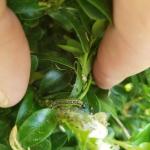
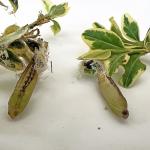
 Box Tree Moth has been detected in the following Massachusetts communities: Bourne, Sandwich, and Barnstable. A map of these locations is available at MDAR’s Invasive Pest Dashboard. If you believe you have found this insect, please take a photo, note your location, and report it immediately to the MA Department of Agricultural Resources using their Report a Pest Form. Box tree moth caterpillars were reported to be active at certain locations on Cape Cod, MA as of the week of April 19th. C.L. Fornari reports on 6/8/2024 that box tree moth pupae are present at a location in Sandwich, MA at this time (see photos). These pupae are likely the overwintered caterpillars that were actively feeding in April which will give rise to the next generation of adults.
Box Tree Moth has been detected in the following Massachusetts communities: Bourne, Sandwich, and Barnstable. A map of these locations is available at MDAR’s Invasive Pest Dashboard. If you believe you have found this insect, please take a photo, note your location, and report it immediately to the MA Department of Agricultural Resources using their Report a Pest Form. Box tree moth caterpillars were reported to be active at certain locations on Cape Cod, MA as of the week of April 19th. C.L. Fornari reports on 6/8/2024 that box tree moth pupae are present at a location in Sandwich, MA at this time (see photos). These pupae are likely the overwintered caterpillars that were actively feeding in April which will give rise to the next generation of adults.
The USDA APHIS has announced a new quarantine for box tree moth in Massachusetts and Ohio, and has expanded existing quarantines in Michigan and New York. This includes conditions for interstate movement of regulated Buxus species. This quarantine includes the entire Commonwealth of Massachusetts. The federal order states:
“Boxwood plants may only be moved interstate from a quarantined area from an establishment operating under a compliance agreement, and only if accompanied by a certificate issued by a State Agricultural Authority certifying that the requirements of this Federal Order and the compliance agreement have been met. These requirements will prevent producers and distributors of boxwood from moving infested plants interstate. State Agricultural Authorities may prescribe additional safeguards and protocols.
All other regulated articles of boxwood, including plant parts, pieces, cuttings, clippings, debris, and any portion of the plant, alive or dead, except for decorative purposes, are prohibited from movement.”
MDAR has recently sent a notice to boxwood growers in Massachusetts of the following:
"Effective May 22, 2024, the USDA has issued a Federal Order establishing a quarantine for the entire state of Massachusetts. In an effort to restrict the movement of box tree moth, boxwoods (Buxus spp.) may no longer be exported from Massachusetts except by an establishment operating under a compliance agreement (CA) to be issued by MDAR. Anyone wishing to register for a CA must go to the Massachusetts Department of Agricultural Resources box tree moth page and click on the EXPORTS link, and fill out the form. An MDAR staff person will follow up within one week. Please note that the quarantine does NOT restrict in-state sales, movement within the state, or import of boxwoods into Massachusetts. If you have any further questions, please feel free to contact either MDAR (taryn.lascola@mass.gov) or USDA (203-741-5641)."
To read the full announcement of the box tree moth quarantine for Massachusetts from MDAR, please visit the Massachusetts Introduced Pests Outreach Blog.
Need information about monitoring and trapping box tree moth? Check out this newly available Box Tree Moth Monitoring & Trapping fact sheet from UMass Extension.
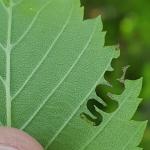
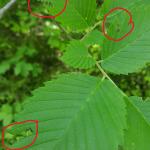 Elm Zigzag Sawfly has been detected in the following Massachusetts communities: Becket, Chester, Windsor, and Williamstown. If you believe you have found this insect, please take a photo, note your location, and report it immediately using MA DCR’s Massachusetts Elm Zigzag Sawfly Reporting Form. Felicia Hubacz, MA DCR, reports elm zigzag sawfly larvae actively feeding in the Becket, MA population as of 5/28/2024. UMass Extension observed tiny elm zigzag sawfly feeding in the Windsor, MA population on 5/31/2024 (see photos).
Elm Zigzag Sawfly has been detected in the following Massachusetts communities: Becket, Chester, Windsor, and Williamstown. If you believe you have found this insect, please take a photo, note your location, and report it immediately using MA DCR’s Massachusetts Elm Zigzag Sawfly Reporting Form. Felicia Hubacz, MA DCR, reports elm zigzag sawfly larvae actively feeding in the Becket, MA population as of 5/28/2024. UMass Extension observed tiny elm zigzag sawfly feeding in the Windsor, MA population on 5/31/2024 (see photos).
Now is the time to search for elm zigzag sawfly larvae actively feeding on their host plants! Please report any suspicious defoliation of elm to the previous reporting link.
- Emerald Ash Borer is well established across most of Massachusetts. A map of these locations from the MA Department of Conservation and Recreation is available.
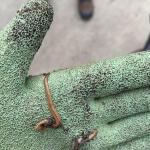
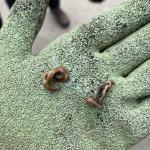 Hammerhead Worms: Also known as flatworms or land planarians, belong to Phylum Platyhelminthes (flat worms) rather than Arthropoda (arthropods) which makes them different from insects and their relatives. Class Insecta is the taxonomic classification of the Insects, whereas hammerhead worms belong to Class Turbellaria. A few common species of non-native hammerhead worms noted in New England include but are not limited to: Bipalium kewense, Bipalium adventitium, and Bipalium pensylvanicum. For more information, see this article in Hort Notes on Hammerhead Worms in New England.
Hammerhead Worms: Also known as flatworms or land planarians, belong to Phylum Platyhelminthes (flat worms) rather than Arthropoda (arthropods) which makes them different from insects and their relatives. Class Insecta is the taxonomic classification of the Insects, whereas hammerhead worms belong to Class Turbellaria. A few common species of non-native hammerhead worms noted in New England include but are not limited to: Bipalium kewense, Bipalium adventitium, and Bipalium pensylvanicum. For more information, see this article in Hort Notes on Hammerhead Worms in New England.
Sightings of these organisms have increased in recent years, possibly due to warming winters and wet summers. Hammerhead worms are predators that prefer to feed on earthworms; however, depending upon the species involved, they may not be an effective predator of certain species of jumping worms. Again in 2024, reports of hammerhead worms have come from parts of Massachusetts (in this case, Martha’s Vineyard; see photos) with questions about safety. Hammerhead worms are known to produce a neurotoxin (tetrodotoxin) which they use in self-defense and to subdue prey. Luckily, hammerhead worms do not produce enough tetrodotoxin to be lethal to humans, but if the neurotoxin comes into contact with exposed skin, irritation may occur. It is advised that handling hammerhead worms should be avoided, and hands or exposed skin be washed with soap and water following any accidental contact.- Jumping Worms are non-native earthworms that impact natural ecosystems. Available resources include a fact sheet about earthworms in Massachusetts and jumping worm FAQ’s.
- Spotted Lanternfly now has established populations in the following locations in Massachusetts: Holyoke, Springfield, West Springfield, Agawam, Fitchburg, Worcester, Shrewsbury, Southborough, Ashland, Wellesley, Weston, Chelmsford and the newest confirmed population in Grafton. The MA Department of Agricultural Resources reported that spotted lanternfly egg hatch had begun in Holyoke and Springfield, MA as of 5/14/2024.
At this point in the growing season, the life stage of spotted lanternfly that is active are the nymphs (immatures). Spotted lanternfly nymphs are black with white spots (instars 1-3) and change their color to include red patches (instar 4) with the black base with white spots just before maturing into adults. Fourth instar nymphs may not be present until sometime in July.
UMass Extension has received reports of suspicious insects that were thought to be adult spotted lanternflies. Adult SLF may not be present in established populations in MA until late July. Right now, we suspect that the suspicious insects that were seen were adult SLF lookalikes, such as some of the tiger moths or underwing moths. The MA Department of Agricultural Resources provides a great spotted lanternfly look-alike sheet for the nymph and adult life stages.
If you believe you have found this insect, please take a photo, note your location, and report it immediately using the Spotted Lanternfly Report Form. Available resources include a map of spotted lanternfly locations in Massachusetts from the MA Department of Agricultural Resources, MDAR’s spotted lanternfly fact sheet, UMass Extension’s Spotted Lanternfly Management Guide, and an SLF InsectXaminer episode.
Medically Important Pests:
- Ticks are a serious public health concern and may be active in managed landscapes any time temperatures are above freezing. Encounters with deer ticks can increase in New England in April, October, and November; however, precautions should be taken year-round to prevent tick bite exposure. Available resources include tick information from Cape Cod Cooperative Extension, personal protective measures, and a list of potential tick testing resources. The New England Center of Excellence in Vector-Borne Diseases (NEWVEC) also provides the latest tick information and resources.
- Mosquitoes and the diseases they vector are also a serious public health concern in Massachusetts by summer. Available resources include Mosquito Repellents from the Department of Public Health and Prevent Mosquito Bites from the Centers for Disease Control and Prevention. The Massachusetts Department of Public Health tests for Eastern Equine Encephalitis (EEE) and West Nile Virus (WNV) from June to October. Beginning June 17th, Massachusetts risk maps will be available for both EEE and WNV.
- Wasps/Hornets: Many wasps are predators of other arthropods, including pest insects such as certain caterpillars that feed on trees and shrubs. Adult wasps hunt prey and bring it back to their nest where young are being reared as food for the immature wasps. A common such example are the paper wasps (Polistes spp.) who rear their young on chewed up insects. Paper wasps can sting, and will defend their nests, which are open-celled paper nests that are not covered with a papery “envelope”. These open-celled nests may be seen hanging from eaves or other outdoor building structures. Aerial yellow jackets and hornets create large aerial nests that are covered with a papery shell or “envelope”. Common yellow jacket species include those in the genus Vespula. Dolichovespula maculata is commonly known as the baldfaced hornet, although it is not a true hornet. The European hornet (Vespa crabro) is three times the size of a yellow jacket and may be confused for the northern giant hornet (Vespa mandarinia). The European hornet is known to Massachusetts, but the northern giant hornet is not. If you are concerned that you have found or photographed a northern giant hornet, please report it using the MA Department of Agricultural Resources Report Pest Sightings page. Some people are allergic to stinging insects, so care should be taken around wasp/hornet nests. Unlike the European honeybee (Apis mellifera), wasps and hornets do not have barbed stingers and therefore can sting repeatedly when defending their nests. It is best to avoid them and, if that cannot be done and assistance is needed to remove them, consult a professional.
Tree & Shrub Insect & Mite Pest Suggested Scouting:
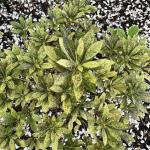 Andromeda Lace Bug is most commonly encountered on Japanese andromeda, however other host plants may be impacted. Most activity from this insect occurs between late May through September, with several generations occurring per year. Both nymphs and adults feed on host plant leaf undersides and cause white/yellow-colored spots or chlorosis to occur on host plant leaf surfaces. This image from 5/9/2024 (Boston, MA) shows Pieris japonica ‘Cavatine’ with old andromeda lace bug feeding damage from 2023 and possible winter injury. Samples were submitted to the UMass Extension Plant Diagnostic Lab. As of now, the new growth is starting to show damage as well, after developing without it. Boston, MA was at 132 GDD’s on 5/12/2024 and andromeda lace bug is known to begin activity by 120 GDD’s. (Image courtesy of Susan Shafer.)
Andromeda Lace Bug is most commonly encountered on Japanese andromeda, however other host plants may be impacted. Most activity from this insect occurs between late May through September, with several generations occurring per year. Both nymphs and adults feed on host plant leaf undersides and cause white/yellow-colored spots or chlorosis to occur on host plant leaf surfaces. This image from 5/9/2024 (Boston, MA) shows Pieris japonica ‘Cavatine’ with old andromeda lace bug feeding damage from 2023 and possible winter injury. Samples were submitted to the UMass Extension Plant Diagnostic Lab. As of now, the new growth is starting to show damage as well, after developing without it. Boston, MA was at 132 GDD’s on 5/12/2024 and andromeda lace bug is known to begin activity by 120 GDD’s. (Image courtesy of Susan Shafer.)- Arborvitae Leafminer moths appear from mid-June to mid-July and lay their eggs. Eggs hatch and larvae enter the leaves where they feed, often unnoticed until January or February when browned leaf tips become more apparent. Feeding from this insect is sometimes confused for winter injury, and vice versa.
- Azalea Lace Bug is a pest of both deciduous and evergreen azaleas (Rhododendron spp.), however resistance has been reported in Rhododendron atlanticum, R. arborescens, R. canescens, R. periclymenoides, and R. prunifolium. The insects feed on host plant leaf undersides, and cause chlorosis on leaf surfaces. Azalea lace bugs are active from 120+ GDD’s throughout the summer.
- Azalea Sawflies is a common name that might refer to three different species of sawflies that feed on azaleas. Adults of Amauronematus azaleae are often present in May and laying eggs which hatch into larvae that typically mature by July 1st. At that time, they finish feeding and drop to the soil to pupate. These green larvae feed on the edges of host plant leaves and may defoliate the plant.
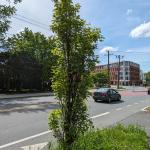
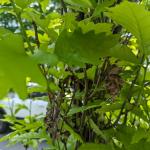

Bagworm caterpillar feeding is underway! Early instar caterpillars (below 2/3 inch in length) are very susceptible to Btk (Bacillus thuringiensis Kurstaki). Apply to actively feeding, young caterpillars once all eggs have hatched, but before caterpillars exceed 2/3 inch in length. For great photos of early-instar bagworms, visit The Ohio State University Extension's Buckeye Yard & Garden onLine (BYGL).

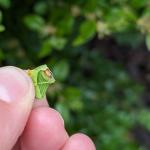 Boxwood Leafminer adult emergence occurs by mid-May, with pupal cases left behind clinging to leaves. Boxwood leafminer pupae were found in boxwood leaves in Berkshire County (Dalton, MA) on 5/11/2024. Shake bushes to detect flying adults. Resistant varieties of boxwood are available; see preceding link.
Boxwood Leafminer adult emergence occurs by mid-May, with pupal cases left behind clinging to leaves. Boxwood leafminer pupae were found in boxwood leaves in Berkshire County (Dalton, MA) on 5/11/2024. Shake bushes to detect flying adults. Resistant varieties of boxwood are available; see preceding link.- Bronze Birch Borer adults emerge from susceptible host plants in early mid-June. Mating and egg laying will occur, and eggs will be laid singly or in groups on host plant bark. Eggs hatch and larvae bore beneath the bark to feed. European white birch (Betula pendula) and Himalayan birch (Betula jacquemontii) are preferred host plants.
- Cankerworms can be found feeding on similar host plants in the spring, despite fall and spring cankerworm being different species of insects. Spring cankerworm adult moths are active in February and March, laying masses of 100 or so eggs in the rough bark of larger branches or the trunk of the host plant. Fall cankerworm adults laid their masses of eggs on host plant branches and twigs, back in late November and early December of last year (sometimes the current year’s January). Egg hatch of both species will occur by approximately mid-May, with caterpillar feeding through roughly the end of June.
- Cryptomeria Scale first generation crawlers are present from approximately 600-800 GDD's and second generation crawlers are present from 1750-2130 GDD's. Look for discolored needles on susceptible host plants. Check the undersides of needles for the hardened scale covers and/or yellow crawlers. Crawlers present in June and August. Scout for scale insects on the underside of needles on the inside of bottom branches first. Scouting on overcast days may make it easier to see the symptoms caused by cryptomeria scale infestation. Yellow sticky cards can be placed in infested trees to aid in scouting for adult (winged) male emergence. Egg laying will begin soon after males are seen. Check scale covers for round exit holes left behind by natural enemies.
- Dogwood Borer is a species of clearwing moth whose larvae bore not only into dogwood (Cornus), but hosts also include flowering cherry, chestnut, apple, mountain ash, hickory, pecan, willow, birch, bayberry, oak, hazel, myrtle, and others. Kousa dogwood appears to be resistant to this species. Signs include the sloughing of loose bark, brown frass, particularly near bark cracks and wounds, dead branches, and adventitious growth. The timing of adult emergence can be expected when dogwood flower petals are dropping and weigela begins to bloom. Adult moth flights continue from then until September.
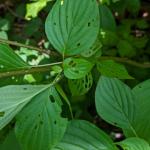
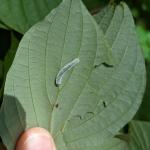 Dogwood Sawfly eggs have hatched and young sawflies are munching their way through dogwood leaves. See photos taken on 5/28/2024 in Chesterfield, MA. Dogwood sawflies are not susceptible to Btk (Bacillus thuringiensis Kurstaki) however, spinosad should be effective on young dogwood sawfly larvae.
Dogwood Sawfly eggs have hatched and young sawflies are munching their way through dogwood leaves. See photos taken on 5/28/2024 in Chesterfield, MA. Dogwood sawflies are not susceptible to Btk (Bacillus thuringiensis Kurstaki) however, spinosad should be effective on young dogwood sawfly larvae.- Euonymus Scale overwinters as a fertilized female. Eggs are laid beneath dark brown female scale covers in the early spring. Egg hatch occurs over a 2-3 week period, with crawlers present by early June. While Euonymus spp. host plants are preferred, additional host plants have been reported.
- Hemlock Looper collectively refers to two species of geometrid (inchworm; looper) caterpillars. Overwintered eggs hatch by late May or early June, at which time young larvae begin their messy feeding on host plant needles. Hemlock and balsam fir are preferred hosts. Hemlock looper caterpillars mature slowly, and may not begin pupation until late July with adults emerging by September and October.
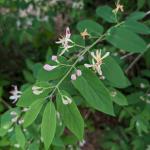
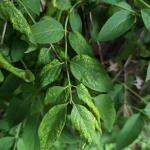
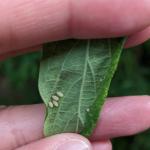 Honeysuckle Aphid is the likely culprit causing leaf curling seen in Williamsburg, MA on honeysuckle on 5/17/2024. This European species of aphid was first detected in North America in Quebec in 1976 and Illinois in 1981. Since then, it has been detected in New England and spread rapidly elsewhere in the United States, likely anywhere bush honeysuckle is grown. Green-colored aphids may be found on the newly opened leaves of host plants in the spring. Look for stunted and curled leaves.
Honeysuckle Aphid is the likely culprit causing leaf curling seen in Williamsburg, MA on honeysuckle on 5/17/2024. This European species of aphid was first detected in North America in Quebec in 1976 and Illinois in 1981. Since then, it has been detected in New England and spread rapidly elsewhere in the United States, likely anywhere bush honeysuckle is grown. Green-colored aphids may be found on the newly opened leaves of host plants in the spring. Look for stunted and curled leaves.- Imported Willow Leaf Beetle adults overwinter in loose bark or other sheltered areas near susceptible Salix and Populus spp. host plants. Once the host plant leaves emerge in the spring, adults will begin to feed and lay tiny, yellow eggs in clusters on leaf undersides. Additional resources include an InsectXaminer episode about imported willow leaf beetle.
- Lily Leaf Beetle, while not a pest of trees and shrubs, can be an important insect found in ornamental landscapes. As soon as lilies break through the ground in the spring, bright red overwintered adult beetles begin feeding on the foliage. This typically occurs in April, with adults mating and laying eggs by May; 250-450 eggs may be laid per female. Additional resources include an InsectXaminer episode about lily leaf beetle.
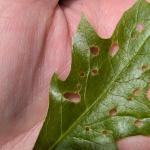
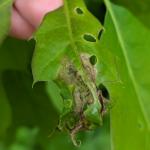
 Oak Shothole Leafminer activity in Massachusetts has alternated between elevated and lacking in certain areas in recent years. Evidence of springtime feeding holes created by adult flies was photographed in Chesterfield, MA on 5/28/2024 along with old, frass-filled leaf mines from the immature feeding larvae. Arborists working in Duxbury, MA also report oak shothole leafminer damage to newly planted oaks on 5/31/24. Mining is reported to occur in the second week in June in Maine, while Ohio reports blotch mine formation by mid-May.
Oak Shothole Leafminer activity in Massachusetts has alternated between elevated and lacking in certain areas in recent years. Evidence of springtime feeding holes created by adult flies was photographed in Chesterfield, MA on 5/28/2024 along with old, frass-filled leaf mines from the immature feeding larvae. Arborists working in Duxbury, MA also report oak shothole leafminer damage to newly planted oaks on 5/31/24. Mining is reported to occur in the second week in June in Maine, while Ohio reports blotch mine formation by mid-May. - Pitch Mass Borer overwinters in the pitch mass found on the host plant. This insect tunnels beneath the bark, into the cambium. It may take up to two years for the pitch mass borer to mature. Pupation typically occurs by the end of May through June, in time for adult clearwing moth emergence in July and August.
- Privet Thrips are a non-native insect pest of privet, lilac, and ash. Thrips feed on the leaves of privet, causing them to appear gray in color made up of chlorotic spots. Immature thrips may be viewed with magnification on the undersides of host plant leaves. Several generations per year may be possible throughout the summer.
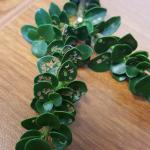
 Redheaded Flea Beetle (Systena frontalis) has been identified as a native pest of nurseries in many locations in the eastern United States. Suspected redheaded flea beetle damage was seen on Ilex crenata 'Dwarf Pagoda' (Dwarf Pagoda Japanese holly) on 3/27/2024 that was purchased in Massachusetts but may have originated in NJ. While identification of this species of insect is uncertain based on host plant damage alone, it appears to be a reasonable and educated assumption. Redheaded flea beetles are known to feed on a wide variety of host plants. These include but are not limited to: cabbage, beans, beets, blueberries, and other agricultural crops as well as Physocarpus, Weigelia, Cornus, Forsythia, Itea, Hydrangea, and Ilex. Adult beetles are active and feed from approximately late-June to mid-September on the upper and lower leaf surfaces of their hosts. This can cause damage that looks like skeletonization and eventually holes in the leaves. Leaves appear covered in brown patches as in these photos. This damage was caused last season on this evergreen plant.
Redheaded Flea Beetle (Systena frontalis) has been identified as a native pest of nurseries in many locations in the eastern United States. Suspected redheaded flea beetle damage was seen on Ilex crenata 'Dwarf Pagoda' (Dwarf Pagoda Japanese holly) on 3/27/2024 that was purchased in Massachusetts but may have originated in NJ. While identification of this species of insect is uncertain based on host plant damage alone, it appears to be a reasonable and educated assumption. Redheaded flea beetles are known to feed on a wide variety of host plants. These include but are not limited to: cabbage, beans, beets, blueberries, and other agricultural crops as well as Physocarpus, Weigelia, Cornus, Forsythia, Itea, Hydrangea, and Ilex. Adult beetles are active and feed from approximately late-June to mid-September on the upper and lower leaf surfaces of their hosts. This can cause damage that looks like skeletonization and eventually holes in the leaves. Leaves appear covered in brown patches as in these photos. This damage was caused last season on this evergreen plant.- Rhododendron Borer is one of the smallest of the native clearwing moths. Adult emergence may begin in May and can last through July, depending upon local temperatures. Rhododendron are preferred host plants, with the larvae of this species boring into stems, often near the base of plants. Injured plant parts may be more attractive to these insects.

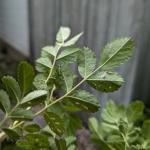 Roseslugs is a common name for at least two species of sawflies whose larvae may be found feeding on the foliage of roses. These small larvae will skeletonize the upper leaf surface and leave a “windowpane”-like pattern behind. If present in large numbers, entire shrubs can be defoliated. Monitor for feeding larvae from the end of May through June. Roseslugs are still feeding as of 5/17/2024 in Williamsburg, MA as pictured here.
Roseslugs is a common name for at least two species of sawflies whose larvae may be found feeding on the foliage of roses. These small larvae will skeletonize the upper leaf surface and leave a “windowpane”-like pattern behind. If present in large numbers, entire shrubs can be defoliated. Monitor for feeding larvae from the end of May through June. Roseslugs are still feeding as of 5/17/2024 in Williamsburg, MA as pictured here.- Southern Pine Beetle has been trapped in Massachusetts since 2015. By 2022 and 2023, southern pine beetle has reached outbreak conditions in small areas of the state, killing pitch pine (Pinus rigida). (Particularly on Martha’s Vineyard and Nantucket islands in MA.) If you believe you have found infested pitch pine in Massachusetts, please report southern pine beetle using the Massachusetts Southern Pine Beetle Reporting Form from MA DCR.
- Spruce Bud Scale overwinters as an immature scale on the undersides of host plant needles. Once spring temperatures warm, the dormant scales become active by late March and in April female spruce bud scales move to host plant twigs. Adult females are reddish-brown and round, and usually found at the base of new twig growth. In this location, they finish maturing and eggs are retained in the female spruce bud scale body cavity where, eventually, crawlers develop. These immature and mobile crawlers appear by approximately the beginning of June and may remain active through July. They then find suitable locations to settle and begin their feeding on the new growth of the plant. During this time, copious amounts of honeydew (sugary liquid excrement) may be excreted.
- Spruce Spider Mite is a cool season mite which causes most of its feeding damage on coniferous hosts in the spring and fall. Monitor for discolored needles and the mites themselves. Monitoring for spruce spider mite can be done by shaking 3-4 branches over a white piece of paper and viewing mites with a hand lens.
- Tuliptree Scale is a soft scale pest of Liriodendron and Magnolia spp. among others. Second instar nymphs overwinter, begin feeding as temperatures warm in the spring, and mature into adults by the late spring/early summer.
- Twospotted Spider Mite season is under way as warm temperatures rise! Populations on many different deciduous and some coniferous hosts may rise from 363-618 GDD's and again from 1300-2000 GDD's. Twospotted spider mites prefer hot, dry conditions in the summer and fall. Population increases and subsequent plant damage can occur under these conditions. Using piercing-sucking mouthparts, mites feed primarily on the underside of host plant leaves and remove fluids. This feeding causes graying or yellowing of the leaves. Necrotic spots can also occur in advanced stages of leaf damage. This may lead to a stippled/bleached appearance of leaves; on occasion, complete defoliation due to spider mite activity is possible under high populations. Twospotted spider mites also create a fine webbing which can be found on infested plants.
Magnification is needed to visually detect twospotted spider mites. At least a 10-15X hand lens is required. The undersides of host plant leaves can be examined for the mites themselves or their shed or cast skins, as well as the fine webbing left behind by spider mites. However, it may be easier to view twospotted spider mites when a branch that is suspected to be infested is shaken or struck over a white piece of paper. See previous link for more details.
- Viburnum Leaf Beetle larvae may be found anywhere on the leaves and usually in groups. When young, larvae feed on the undersides of the leaves. As they grow larger, they may feed on the upper surface. Larval development may take approximately 8-10 weeks to complete and 3 larval instars are reported. Pupae are yellowish and are found in the soil beneath the host plant. Adults emerge around the middle of July and are brown, smaller than the largest larvae (approximately ¼ inch), and will also feed on the leaves. Adults are present in the landscape until the first hard frost.
- White Pine Aphid is a large, black, long-legged aphid found on twigs and small branches of eastern white pine. Search for aphids beginning in May and June. As the season progresses, honeydew and sooty mold may coat branches and needles of the host plant.
- White Spotted Pine Sawyer is a native longhorned beetle that is often confused for the invasive Asian longhorned beetle (see entry above). White spotted pine sawyer adults emerge in late May throughout July in MA. This insect completes its life cycle in weakened or recently dead conifers, particularly eastern white pine (Pinus strobus). It is not a significant pest. However, if you are unsure of the identification of a longhorned beetle, always take a photo and report it. You can report suspicious insects at the MA Department of Agricultural Resources Introduced Species Outreach Project Report a Pest Form.
- Woolly Beech Leaf Aphid overwinters as eggs in host plant bark crevices near buds. At budbreak, eggs hatch and wool covered aphids begin feeding on host plant leaf undersides (Fagus spp.). Even though aphid populations may be very noticeable, they seldom require chemical management.
- Yellow Poplar Weevil is also known as the sassafrass weevil, the magnolia leafminer, or the tulip tree leafminer. This insect, as all of these common names suggest, feeds on yellow poplar (tulip tree; Liriodendron tulipifera), sassafras (Sassafras albidum), magnolia (Magnolia spp.), as well as bay laurel (Laurus nobilis). Adult beetles lay eggs in the midribs of host plant leaves by May, after which the eggs hatch and larvae feed by creating blotch mines in the leaves. Larvae can be observed in May and June, and adults emerging to feed again by August, prior to overwintering in sheltered areas.
Beneficials/Non-Pests:
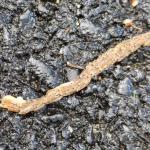 Sciaridae are known as the dark-winged fungus gnats. They are harmless to people, pets, or plants and live in decomposing organic matter in wooded areas. Their larvae sometimes move about in long, almost snake-like masses. This happens under wet conditions near wooded areas, and is sometimes observed across driveways. They do not need to be managed, and can be left alone. However, the sight of them moving around may startle some viewers.
Sciaridae are known as the dark-winged fungus gnats. They are harmless to people, pets, or plants and live in decomposing organic matter in wooded areas. Their larvae sometimes move about in long, almost snake-like masses. This happens under wet conditions near wooded areas, and is sometimes observed across driveways. They do not need to be managed, and can be left alone. However, the sight of them moving around may startle some viewers.
Report by Tawny Simisky, Extension Entomologist, UMass Extension Landscape, Nursery & Urban Forestry Program
Landscape Weeds
For information about identification of weeds noted below, check out UMass Extension's Weed Herbarium.
Scout for annual weeds in ornamental beds: Recent rainfall and warm weather has pushed summer annual weed germination and establishment along. IIf a preemergence herbicide was applied earlier in the season, now is a good time to begin determining if the application provided effective control. Treat these weeds before they get too large. Spot spraying with a non-selective herbicide (glyphosate or glufosinate) is usually a better strategy than hand-weeding as it does not break the mulch barrier.
Crabgrass (and other annual grassy weed) management in turf: Recent rainfall and warmer temperatures are moving crabgrass along. Monitor turf areas for the emergence of crabgrass and other annual grassy weeds. Routine monitoring should be conducted on all turf areas regardless of whether they received a preemergence herbicide application. Crabgrass montoring will be easier along hardscape edges and thinner turf stands. After crabgrass has germinated, it can be controlled with several postemergence herbicides. Postemergence herbicides vary in their ability to control crabgrass at its different stages of growth (see table below). Determination of the predominant growth stage will dictate the herbicide selection.
|
Postemergence Herbicide |
Crabgrass Growth Stage LF = leaf, TL = tiller |
|||||
|---|---|---|---|---|---|---|
|
1- to 5-LF |
1-TL |
2-TL |
3-TL |
4-TL |
5-TL & up |
|
|
dithiopyr |
YES |
YES |
YES |
YES |
NO |
NO |
|
mesotrione |
YES |
YES |
YES |
YES |
NO |
NO |
|
quinclorac |
YES |
YES |
NO |
NO |
NO |
YES |
|
fenoxaprop |
YES |
YES |
NO |
NO |
NO |
NO |
White clover: Flowering now or just past its flowering, now is the best time to control white clover in turf areas if needed. The best herbicides for postemergence white clover control are mecoprop, (MCPP), quinclorac, clopyralid, and fluroxypyr. These herbicides are common active ingredients in many broadleaf combination products labelled for turf. MCPP, quinclorac, and clopyralid are also available as single-active products. Clopyralid carries a label restriction and cannot be used on residential turf, but can be used on all other turf sites (golf courses, commercial turf, and athletic fields).
Japanese knotweed (Fallopia japonica): Do not attempt to control Japanese knotweed now, as herbicide applications are not effective in the early part of the growing season. In preparation for a late season herbicide application, cut or mow stands of knotweed to the ground in late May and early June. This practice is done to facilitate herbicide application by removing the dried stems from the previous year’s growth and will control plant height to make herbicide treatment easier in late summer. There is also some indication that the plant’s carbohydrate reserves may be reduced with this early season mowing.
Ground ivy (Glechoma hederacea) in turf and landscape: This often “tough-to-manage” weed is currently in full flower or just past full flower. Management of ground ivy is usually not effective during the early part of the growing season. The best control of ground ivy is achieved with an application of a broadleaf turf herbicide product that contains triclopyr in September and October. Ground ivy in landscape beds can be controlled now with a direct-spray application of glyphosate or glufosinate.
Garlic mustard (Alliaria petiolata): This biennial weed is considered invasive in Massachusetts and other Northeast states. Second year plants have completed their flowering period and seedpods are still green. Green seedpods contain seeds that are not yet mature and so lack reproductive ability. An herbicide application now will control the second-year plants before they produce viable seed as well as the first-year seedling plants that are germinating below the canopy of second-year plants.
Report by Randy Prostak, Weed Specialist, UMass Extension Landscape, Nursery, and Urban Forestry Program
Additional Resources
Pesticide License Exams by the MA Dept. of Agricultural Resources (MDAR) are now held online. More information and how to register.
To receive immediate notification when the next Landscape Message update is posted, join our e-mail list or follow us on Facebook.
For a complete listing of landscape, nursery, and urban forestry program upcoming events, see our Events calendar.
For commercial growers of greenhouse crops and flowers - Check out UMass Extension's Greenhouse Update website.
For professional turf managers - Check out our Turf Management Updates.
For home gardeners and garden retailers - Check out our home lawn and garden resources.
Diagnostic Services
UMass Laboratory Diagnoses Landscape and Turf Problems - The UMass Extension Plant Diagnostic Lab is available to serve commercial landscape contractors, turf managers, arborists, nurseries and other green industry professionals. It provides woody plant and turf disease analysis, woody plant and turf insect identification, turfgrass identification, weed identification, and offers a report of pest management strategies that are research based, economically sound and environmentally appropriate for the situation. Accurate diagnosis for a turf or landscape problem can often eliminate or reduce the need for pesticide use. For sampling procedures, detailed submission instructions and a list of fees, see the Plant Diagnostic Laboratory web site.
Soil and Plant Nutrient Testing - The University of Massachusetts Soil and Plant Nutrient Testing Laboratory is located on the campus of the University of Massachusetts at Amherst. Testing services are available to all. The lab provides test results and recommendations that lead to the wise and economical use of soils and soil amendments. For more information, including current turn-around times, visit the UMass Soil and Plant Nutrient Testing Laboratory web site. The lab is currently accepting orders for Routine Soil Analysis (including optional Organic Matter, Soluble Salts, and Nitrate testing), Particle Size Analysis, Pre-Sidedress Nitrate (PSNT), Total Sorbed Metals, and Soilless Media (no other types of soil analyses available at this time). Check for current turnaround time. Please plan for the fact that date of receipt in the lab is affected by weekends, holidays, shipping time, and time for UMass Campus Mail to deliver samples to the lab.
Tick Testing - The UMass Center for Agriculture, Food, and the Environment provides a list of potential tick identification and testing options.
Acknowledgements: UMass Extension gratefully acknowledges the support of the following funding sources for the production of the Landscape Message
- The Massachusetts Nursery and Landscape Association Fund
- The Massachusetts Department of Conservation and Recreation, Award #ISADCR28219926UMA24A
- Stakeholders like you! The Landscape Message is partially supported by educational program user fees.